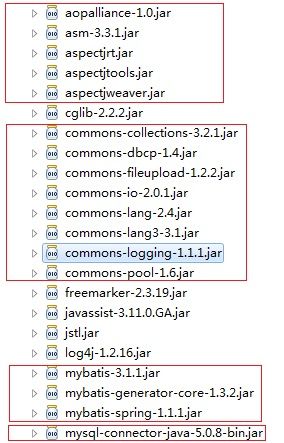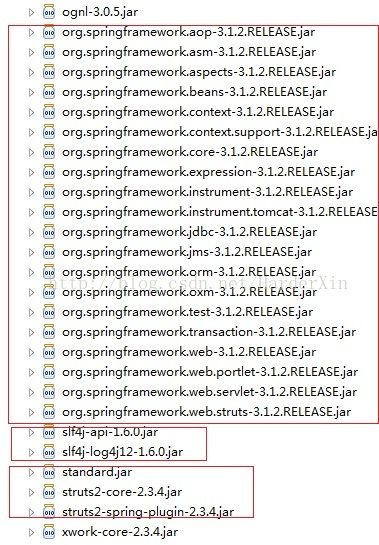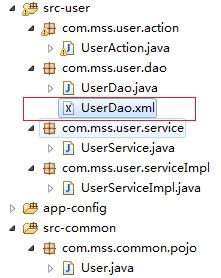转 :手动配置三大框架整合:Spring+Struts2+mybatis
现在主流的项目框架中,数据库持久层有可能不是hibernate,而是mybatis或者ibatis,其实它们都是一样的,下面我来把环境搭建一下:
【导入相关jar包】新建web项目工程mss,Spring+Struts2+mybatis整合,除了Spring和Struts的jar包外(可以在我的资源中下载),我们还需导入mybatis的几个想jar包:
三大框架整合后jar包:
【配置web.xml】
|
1
2
3
4
5
6
7
8
9
10
11
12
13
14
15
16
17
18
19
20
21
22
23
24
25
26
27
28
29
30
31
32
33
34
35
36
37
38
39
40
41
|
<!--?xml version=
"1.0"
encoding=
"UTF-8"
?-->
<web-app version=
"2.5"
xmlns=
"http://java.sun.com/xml/ns/javaee"
xmlns:xsi=
"http://www.w3.org/2001/XMLSchema-instance"
xsi:schemalocation="http://java.sun.com/xml/ns/javaee
http:
//java.sun.com/xml/ns/javaee/web-app_2_5.xsd">
<welcome-file-list>
<welcome-file>index.jsp</welcome-file>
</welcome-file-list>
<!-- struts启动配置 -->
<filter>
<filter-name>struts2</filter-name>
<filter-
class
>org.apache.struts2.dispatcher.ng.filter.StrutsPrepareAndExecuteFilter</filter-
class
>
</filter>
<filter-mapping>
<filter-name>struts2</filter-name>
<url-pattern>/*</url-pattern>
</filter-mapping>
<!-- spring启动加载配置 -->
<context-param>
<param-name>contextConfigLocation</param-name>
<param-value>classpath:springConfig/applicationContext-*.xml</param-value>
</context-param>
<listener>
<listener-
class
>
org.springframework.web.context.ContextLoaderListener
</listener-
class
>
</listener>
<!-- log4j相关配置 -->
<context-param>
<param-name>log4jConfigLocation</param-name>
<param-value>/WEB-INF/classes/log4j.properties</param-value>
</context-param>
<context-param>
<param-name>log4jRefreshInterval</param-name>
<param-value>
60000
</param-value>
</context-param>
<listener>
<listener-
class
>org.springframework.web.util.Log4jConfigListener</listener-
class
>
</listener>
</web-app>
|
【Spring公共配置 applicationContext-common.xml】
|
1
2
3
4
5
6
7
8
9
10
11
12
13
14
15
16
17
18
19
20
21
22
23
24
25
26
27
28
29
30
31
32
33
34
35
36
37
38
39
40
41
42
43
44
45
46
47
48
|
<!--?xml version=
"1.0"
encoding=
"UTF-8"
?-->
<beans xmlns=
"http://www.springframework.org/schema/beans"
xmlns:xsi=
"http://www.w3.org/2001/XMLSchema-instance"
xmlns:aop=
"http://www.springframework.org/schema/aop"
xmlns:tx=
"http://www.springframework.org/schema/tx"
xsi:schemalocation="
http:
//www.springframework.org/schema/beans
http:
//www.springframework.org/schema/beans/spring-beans-3.0.xsd
http:
//www.springframework.org/schema/tx
http:
//www.springframework.org/schema/tx/spring-tx-3.0.xsd
http:
//www.springframework.org/schema/aop
http:
//www.springframework.org/schema/aop/spring-aop-3.0.xsd">
<!-- 读取配置文件 -->
<bean id=
"propertyConfigurer"
class
=
"org.springframework.beans.factory.config.PropertyPlaceholderConfigurer"
>
<property name=
"location"
value=
"classpath:jdbc.properties"
>
</property></bean>
<!-- 数据库连接池 -->
<bean id=
"dataSource"
class
=
"org.apache.commons.dbcp.BasicDataSource"
destroy-method=
"close"
>
<property name=
"driverClassName"
>
<value>${jdbc_driver}</value>
</property>
<property name=
"url"
>
<value>${jdbc_url}</value>
</property>
<property name=
"username"
>
<value>${jdbc_user}</value>
</property>
<property name=
"password"
>
<value>${jdbc_password}</value>
</property>
<property name=
"maxActive"
value=
"100"
></property>
<property name=
"maxIdle"
value=
"30"
></property>
<property name=
"maxWait"
value=
"500"
></property>
<property name=
"defaultAutoCommit"
value=
"true"
></property>
</bean>
<!-- 事务配置 -->
<bean id=
"transactionManager"
class
=
"org.springframework.jdbc.datasource.DataSourceTransactionManager"
>
<property name=
"dataSource"
ref=
"dataSource"
>
</property></bean>
<!-- 实体映射类-->
<bean id=
"sqlSessionFactory"
class
=
"org.mybatis.spring.SqlSessionFactoryBean"
>
<property name=
"dataSource"
ref=
"dataSource"
>
<property name=
"typeAliasesPackage"
value=
"com.mss.common.pojo"
>
</property></property></bean>
</aop:aspectj-autoproxy></beans>
|
【struts2公共配置】
|
1
2
3
4
5
6
7
8
9
10
11
12
13
14
15
16
|
<!--?xml version=
"1.0"
encoding=
"UTF-8"
?-->
<struts>
<!-- 将struts2交给spring管理-->
<constant name=
"struts.configuration.xml.reload"
value=
"true"
>
<constant name=
"struts.action.extension"
value=
"action,do,webwork"
>
<constant name=
"struts.enable.DynamicMethodInvocation"
value=
"true"
>
<constant name=
"struts.devMode"
value=
"true"
>
<constant name=
"struts.multipart.maxSize"
value=
"100971520"
></constant>
<constant name=
"struts.i18n.encoding"
value=
"UTF-8"
></constant>
<constant name=
"struts.objectFactory.spring.autoWire"
value=
"name"
></constant>
<constant name=
"struts.objectFactory"
value=
"spring"
></constant>
<constant name=
"struts.custom.i18n.resources"
value=
"messages"
></constant>
<include file=
"strutsConfig/struts-user.xml"
></include>
</constant></constant></constant></constant></struts>
|
【创建数据表结构】:项目中我们使用的是mysql数据库,在里面新建了一个user表:
【搭建项目结构】:这里我使用了三层架构:Action-->Service-->Dao(实体类)
编写user实体类:
|
1
2
3
4
5
6
7
8
9
10
11
12
13
14
15
16
17
18
19
20
21
22
23
24
25
26
27
28
29
30
31
32
33
34
35
36
37
38
39
40
41
42
43
44
45
46
47
48
49
|
package
com.mss.common.pojo;
import
java.io.Serializable;
public
class
User
implements
Serializable {
/**
*
*/
private
static
final
long
serialVersionUID = 1L;
private
String id;
private
String userName;
private
String password;
private
String email;
public
String getId() {
return
id;
}
public
void
setId(String id) {
this
.id = id;
}
public
String getUserName() {
return
userName;
}
public
void
setUsername(String userName) {
this
.userName = userName;
}
public
String getPassword() {
return
password;
}
public
void
setPassword(String password) {
this
.password = password;
}
public
String getEmail() {
return
email;
}
public
void
setEmail(String email) {
this
.email = email;
}
}
|
编写我们的dao层UserDao:
|
1
2
3
4
5
6
7
8
9
10
11
12
13
14
15
16
17
18
19
20
21
22
23
24
25
26
|
package
com.mss.user.dao;
import
java.util.List;
import
com.mss.common.pojo.User;
public
interface
UserDao {
/**
* 添加用户
* @param user
*/
public
void
addUser(User user);
/**
* 列出所有用户
* @return
*/
public
List<user> queryUsers();
/**
* 删除用户
* @param id
*/
public
void
delUser(String id);
}
</user>
|
使用mybatis,我们得配置xml文件,将实体类User与表user映射,也将UserDao中的方法进行映射实现,这样我们不需要写UserDaoImpl,因为对数据库的操作也在这个xml中进行:UserDao.xml,这个很重要
|
1
2
3
4
5
6
7
8
9
10
11
12
13
14
15
16
17
18
19
20
21
22
23
24
25
26
27
28
29
30
31
32
33
34
35
36
37
38
39
40
|
<!--?xml version=
"1.0"
encoding=
"UTF-8"
?-->
<mapper namespace=
"com.mss.user.dao.UserDao"
>
<!-- User实体类、User表映射,注意实体类User和表名应该一致,字段下面可配置 -->
<resultmap id=
"UserMap"
type=
"com.mss.common.pojo.User"
>
<result property=
"id"
column=
"ID"
>
<result property=
"userName"
column=
"USERNAME"
>
<result property=
"password"
column=
"PASSWORD"
>
<result property=
"email"
column=
"EMAIL"
>
</result></result></result></result></resultmap>
<!-- 将UserDao中的方法进行配置,id=方法名称,parameterType=参数类型,resultMap返回的结果,
当用户使用UserDao中的方法时,mybaties自己会找相应配置文件中的对数据库的操作 -->
<insert id=
"addUser"
parametertype=
"User"
>
INSERT INTO USER(
ID,
USERNAME,
PASSWORD,
EMAIL
)
VALUES (
#{id},
#{userName},
#{password},
#{email}
)
</insert>
<!-- 返回一个上面的 resultMap实例,这里的resultMap要与上面的配置的resultMap中的id一致-->
<select id=
"queryUsers"
resultmap=
"UserMap"
>
SELECT * FROM USER
</select>
<!-- 删除信息 -->
<delete id=
"delUser"
parametertype=
"string"
>
DELETE FROM USER WHERE ID = #{id}
</delete>
</mapper>
|
编写我们的Service和ServiceImpl类,操作Dao层:UserService、UserServiceImpl
|
1
2
3
4
5
6
7
8
9
10
11
12
13
14
15
16
17
18
19
20
|
public
interface
UserService {
/**
* 添加用户
* @param user
*/
public
void
addUser(User user);
/**
* 列出所有的用户
* @return
*/
public
List<user> queryUsers();
/**
* 删除用户
* @param id
*/
public
void
delUser(String id);
}
</user>
|
|
1
2
3
4
5
6
7
8
9
10
11
12
13
14
15
16
17
18
19
20
21
22
23
24
25
26
27
28
29
30
31
32
33
34
35
36
37
38
39
40
41
42
43
44
45
|
package
com.mss.user.serviceImpl;
import
java.util.List;
import
com.mss.common.pojo.User;
import
com.mss.user.dao.UserDao;
import
com.mss.user.service.UserService;
public
class
UserServiceImpl
implements
UserService{
private
UserDao userDao;
public
UserDao getUserDao() {
return
userDao;
}
public
void
setUserDao(UserDao userDao) {
this
.userDao = userDao;
}
/**
* 添加用户
*/
public
void
addUser(User user) {
userDao.addUser(user);
}
/**
* 列出所有用户
*/
public
List<user> queryUsers() {
List<user> userList = userDao.queryUsers();
return
userList;
}
/**
* 删除用户
*/
public
void
delUser(String id) {
userDao.delUser(id);
}
}
</user></user>
|
编写Action,操作Service,UserAction
|
1
2
3
4
5
6
7
8
9
10
11
12
13
14
15
16
17
18
19
20
21
22
23
24
25
26
27
28
29
30
31
32
33
34
35
36
37
38
39
40
41
42
43
44
45
46
47
48
49
50
51
52
53
54
55
56
57
58
59
60
61
62
63
64
65
66
67
68
69
70
71
72
73
74
75
76
77
78
79
80
81
82
83
84
85
86
87
88
89
90
91
92
93
94
95
96
|
/**
* 用户操作Action
* @author dell
*
*/
public
class
UserAction
extends
ActionSupport {
private
static
final
long
serialVersionUID = 1L;
private
static
Logger logger = Logger.getLogger(UserAction.
class
);
public
UserService userService;
public
UserService getUserService() {
return
userService;
}
public
void
setUserService(UserService userService) {
this
.userService = userService;
}
private
String id;
private
String userName;
private
String password;
private
String email;
/**
* 添加用户信息
*
* @return
*/
public
String addUser() {
User user =
new
User();
try
{
String iid =
new
Random().nextInt(
100
)+
""
;
user.setId(iid);
user.setUsername(userName);
user.setPassword(password);
user.setEmail(email);
userService.addUser(user);
}
catch
(Exception e) {
logger.error(
"exception in add user"
, e);
return
ERROR;
}
return
SUCCESS;
}
/**
* 从数据库中获得所有的用户信息
*
* @return
*/
public
String queryUsers() {
try
{
List<user> userList = userService.queryUsers();
for
(
int
i =
0
; i < userList.size(); i++) {
System.out.println(userList.get(i).getId());
}
HttpServletRequest request = ServletActionContext.getRequest();
request.setAttribute(
"list"
, userList);
return
"list"
;
}
catch
(Exception e) {
logger.error(
"Exception in queryUsers"
, e);
return
ERROR;
}
}
/**
* 删除用户信息
*
* @return
*/
public
String delUser() {
try
{
userService.delUser(id);
}
catch
(Exception e) {
logger.error(
"Exception in delUser"
, e);
return
ERROR;
}
return
SUCCESS;
}
public
void
setId(String id) {
this
.id = id;
}
public
void
setUserName(String userName) {
this
.userName = userName;
}
public
void
setPassword(String password) {
this
.password = password;
}
public
void
setEmail(String email) {
this
.email = email;
}
}</user>
|
整体代码结构:
其中,跟mybatis相关最大的一个就是UserDao.xml文件了,我们的所有对数据库的操作和方法都可以在里面进行相应的配置和参数设置,只要将相应的名称设置和匹配好,mybatis就能够自动调用
【配置我们自己的spring xml文件:applicationContext-user.xml】,其中mybatis和spring集成的下面属性配置很重要:,下面有相应注解
|
1
2
3
4
5
6
7
8
9
10
11
12
13
14
15
16
17
18
19
20
21
22
23
24
25
|
<!--?xml version=
"1.0"
encoding=
"UTF-8"
?-->
<beans xmlns=
"http://www.springframework.org/schema/beans"
xmlns:xsi=
"http://www.w3.org/2001/XMLSchema-instance"
xmlns:aop=
"http://www.springframework.org/schema/aop"
xmlns:tx=
"http://www.springframework.org/schema/tx"
xsi:schemalocation="
http:
//www.springframework.org/schema/beans
http:
//www.springframework.org/schema/beans/spring-beans-3.0.xsd
http:
//www.springframework.org/schema/tx
http:
//www.springframework.org/schema/tx/spring-tx-3.0.xsd
http:
//www.springframework.org/schema/aop
http:
//www.springframework.org/schema/aop/spring-aop-3.0.xsd">
<!-- 操作User类的spring配置文件 -->
<!-- 配置User中的Dao类,使mybaties能够配置User与数据库打交道 -->
<!-- 能够映射User.xml文件-->
<bean
class
=
"org.mybatis.spring.mapper.MapperScannerConfigurer"
>
<property name=
"basePackage"
value=
"com.mss.user.dao"
>
</property></bean>
<!-- 配置userService,注意 userDao名称要与UserServiceImpl中的UserDao属性名称一样-->
<bean id=
"userService"
class
=
"com.mss.user.serviceImpl.UserServiceImpl"
>
<property name=
"userDao"
ref=
"userDao"
>
</property></bean>
<!-- 配置Action,注意userService名称要与UserAction中的UserService属性名称一样 -->
<bean id=
"userAction"
class
=
"com.mss.user.action.UserAction"
>
<property name=
"userService"
ref=
"userService"
>
</property></bean>
</beans>
|
【配置自己的Struts xml:struts-user.xml】
|
1
2
3
4
5
6
7
8
9
10
11
|
<!--?xml version=
"1.0"
encoding=
"UTF-8"
?-->
<struts>
<
package
name=
"user"
extends
=
"struts-default"
namespace=
"/"
>
<result name=
"success"
>success.jsp</result>
<result name=
"error"
>error.jsp</result>
<result name=
"list"
>UserList.jsp</result>
</action>
</
package
>
</struts>
|
【项目中我们用到了log4j,配置log4j.properties】
项目的基础配置基本完成,编写我们的视图层,上面Action中我们跳转到了UserList.jsp,编写我们的jsp显示页面:
|
1
2
3
4
5
6
7
8
9
10
11
12
13
14
15
16
17
18
19
20
|
<%@ page language=
"java"
contentType=
"text/html; charset=UTF-8"
pageEncoding=
"UTF-8"
%>
<%@ taglib uri=
"http://java.sun.com/jsp/jstl/core"
prefix=
"c"
%>
<meta http-equiv=
"Content-Type"
content=
"text/html; charset=UTF-8"
>
<title>Insert title here</title>
<c:foreach items=
"${list}"
var=
"s"
>
</c:foreach><br><table border=
"1"
>
<tbody><tr>
<td><c:out value=
"${s.userName}"
></c:out></td>
<td><c:out value=
"${s.password}"
></c:out></td>
<td><c:out value=
"${s.email}"
></c:out></td>
<td>删除记录</td>
</tr>
</tbody></table>
|
好了,基础环境基本上已经搭建完成,将项目部署到Tomcat上,启动Tom家的猫,如果没报错,说明我们项目搭建成功,输入下面地址:http://localhost:8080/MybatiesSS/userAction!queryUsers.do,如果数据库中没有数据,则加入相应数据,如果显示出相应的数据库记录,说明我们项目搭建成功!
完整项目可在我的资源库中下载:http://download.csdn.net/detail/harderxin/7308169
相比较hibernate来说:
hibernate:要编写实体类和实体类相映射数据库表的xml文件,然后操作数据库使用hibernate封装的java类接口
mybatis:编写实体类、实体类相映射数据库表的xml文件、对数据方法操作xml文件,其对数据库的操作也在xml文件中定义,基本上使用的是纯sql语句
|
1
|
mybatis是半自动的,hibernate是全自动的,就是说mybatis可以配置sql语句,对于sql调优来说是比较好的,hibernate会自动生成所有的sql语句,调优不方便,hibernate用起来难度要大于mybatis。mybatis的主要思想是sql Mapping,而hibernate是OR Mapping,mybatis应用到项目中会比较直观一点,能直接看到sql,而hibernate是通过操作对象操作数据,可以很灵活的运用于不同的数据库之间
|
要比较hibernate与mybatis的区别,大家还可以参考博客:http://blog.csdn.net/firejuly/article/details/8190229
上面只是粗略的讲解了一下mybatis与Spring和struts的项目整合,并没有对mybatis有很详细的讲解,其实它学起来也挺容易的,希望大家有时间能自己去了解一下!!
转自http://www.2cto.com/kf/201412/364356.html






